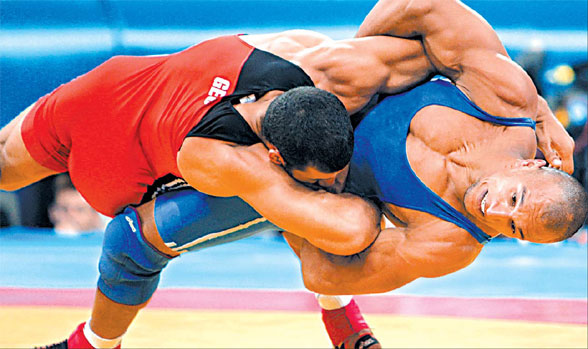No submission, no surrender
By Chen Xiangfeng
Updated: 2008-05-30 10:30
|

Egypt's Karam Ibrahim (right) throws Georgia's Ramaz Nozadze in the men's Greco-Roman 96 kg final at the Athens Games. Ibrahim took the gold. AFP
|
Known for its clinches, holds and locks, wrestling has been an Olympic sport for over 100 years.
Greco-Roman wrestling
Greco-Roman wrestling dates back to the early 19th century and a soldier named Exbroyat who performed "flat hand wrestling" at fairs in the French town of Lyon.
In 1848, he established a rule barring holds underneath the waist, and forbidding holds and painful torsions that could hurt the adversary.
Also known as "French wrestling," it quickly spread through Europe and became the most important sport of the century. Basilio Bartoli of Italy came up with the expression "Greco-Roman" to stress the connection with the values of ancient Greece.
Greco-Roman was the first style registered at the Modern Olympic Games in Athens in 1896 and this form of professional entertainment became a first-class amateur sport during the next century.
Wrestling has so far only missed one Olympics - the Paris Games of 1900 - and now has seven weight categories, spanning 55 kg to 120 kg.
According to the world rankings compiled after the last World Cup of Greco-Roman wrestling, the top five countries in this style are: Russia, Hungary, Iran, Georgia, South Korea and the United States.
Cuba, Sweden, Armenia and Egypt form a second-tier.
'Catch-as-catch-can'
Freestyle wrestling authorizes leg holds in the execution of every action.
It developed in Great Britain and the United States under the name of catch-as-catch-can and became a favorite attraction in fairs and popular celebrations during the 19th century.
The goal of this discipline was to bring the adversary's shoulder to the ground and almost all holds were allowed.
Wrestling in the United States was an extremely popular sport, and about half a dozen American presidents practiced it, including George Washington, Theodore Roosevelt and Abraham Lincoln.
Freestyle wrestling was introduced at the Saint Louis Olympic Games in 1904. All 40 wrestlers who participated were of American nationality. Competition rules were similar to those of catch-as-catch-can, with some restrictions concerning dangerous holds.
At present, it counts seven weight categories, similar to those found in the Greco-Roman discipline.
Russia again leads the world rankings, followed by Cuba, Uzbekistan, Ukraine, the United States and Turkey.
No double Nelsons
Female wrestling is similar to freestyle but without the double headlocks (double Nelsons), which are deemed too dangerous for women.
Amateur female wrestling was first practiced in France and Scandinavian countries in the 1980s.
The first World Championships were held in Lorenskog, Norway in 1987 and it joined the Olympics at Athens 2004.
It currently features seven weight categories, from 48 kg to 72 kg, but only four of these made it to the Olympic program.
Beijing Games host China is the current world leader trailed by the United States, Japan, Kazakhstan, Ukraine and Canada.
Across oceans of time
Widely recognized as the world's oldest competitive sport, wrestling appeared in a series of Egyptian wall paintings 5,000 years ago.
When the ancient Olympic Games began in 776 BC, more than two millenniums later, wrestling was a main event.
It would return in a similar capacity when the Olympic Games was reborn in 1896 after a 1,500-year absence.
Organizers resurrected Greco-Roman wrestling, a style they believed to be an exact carryover from the Greek and Roman wrestlers of yore.
In this style, the wrestlers used only their arms and upper bodies to attack. They could hold only the same body parts of their opponents. It worked nicely from a historical perspective, but another breezier style was sweeping across Great Britain and the United States by then. Known as "catch-as-catch-can", it had become standard fare - and popular professional entertainment - at fairs and festivals in both countries.
In 1904, the Olympic Games added the second wrestling event and called it "freestyle". Now, wrestlers could use their legs for pushing, lifting and tripping, and they could hold opponents above or below the waist.
(China Daily 05/30/2008 page12)
|